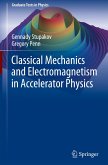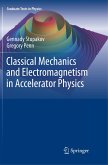Volker Ziemann
Hands-On Accelerator Physics Using MATLAB(R)
Volker Ziemann
Hands-On Accelerator Physics Using MATLAB(R)
- Gebundenes Buch
- Merkliste
- Auf die Merkliste
- Bewerten Bewerten
- Teilen
- Produkt teilen
- Produkterinnerung
- Produkterinnerung
Hands-On Accelerator Physics Using MATLAB(R), second edition provides a broad introduction into the physics and the technology of particle accelerators from synchrotron light sources to high-energy colliders.
Andere Kunden interessierten sich auch für
![Classical Mechanics and Electromagnetism in Accelerator Physics Classical Mechanics and Electromagnetism in Accelerator Physics]() Gennady StupakovClassical Mechanics and Electromagnetism in Accelerator Physics64,99 €
Gennady StupakovClassical Mechanics and Electromagnetism in Accelerator Physics64,99 €![Introduction to Engineering Nonlinear and Parametric Vibrations with MATLAB and Maple Introduction to Engineering Nonlinear and Parametric Vibrations with MATLAB and Maple]() Alan B PalazzoloIntroduction to Engineering Nonlinear and Parametric Vibrations with MATLAB and Maple113,99 €
Alan B PalazzoloIntroduction to Engineering Nonlinear and Parametric Vibrations with MATLAB and Maple113,99 €![Magnetism and Accelerator-Based Light Sources Magnetism and Accelerator-Based Light Sources]() Magnetism and Accelerator-Based Light Sources38,99 €
Magnetism and Accelerator-Based Light Sources38,99 €![Classical Mechanics and Electromagnetism in Accelerator Physics Classical Mechanics and Electromagnetism in Accelerator Physics]() Gennady StupakovClassical Mechanics and Electromagnetism in Accelerator Physics45,99 €
Gennady StupakovClassical Mechanics and Electromagnetism in Accelerator Physics45,99 €![IoT Enabled-DC Microgrids IoT Enabled-DC Microgrids]() IoT Enabled-DC Microgrids139,99 €
IoT Enabled-DC Microgrids139,99 €![Interactions Interactions]() Bicky A MarquezInteractions64,99 €
Bicky A MarquezInteractions64,99 €![Physics Physics]() Michael J R HochPhysics148,99 €
Michael J R HochPhysics148,99 €-
-
-
Hands-On Accelerator Physics Using MATLAB(R), second edition provides a broad introduction into the physics and the technology of particle accelerators from synchrotron light sources to high-energy colliders.
Produktdetails
- Produktdetails
- Verlag: Taylor & Francis Ltd (Sales)
- 2nd edition
- Seitenzahl: 398
- Erscheinungstermin: 31. März 2025
- Englisch
- Abmessung: 261mm x 188mm x 35mm
- Gewicht: 954g
- ISBN-13: 9781032726960
- ISBN-10: 1032726962
- Artikelnr.: 71808340
- Herstellerkennzeichnung
- Libri GmbH
- Europaallee 1
- 36244 Bad Hersfeld
- gpsr@libri.de
- Verlag: Taylor & Francis Ltd (Sales)
- 2nd edition
- Seitenzahl: 398
- Erscheinungstermin: 31. März 2025
- Englisch
- Abmessung: 261mm x 188mm x 35mm
- Gewicht: 954g
- ISBN-13: 9781032726960
- ISBN-10: 1032726962
- Artikelnr.: 71808340
- Herstellerkennzeichnung
- Libri GmbH
- Europaallee 1
- 36244 Bad Hersfeld
- gpsr@libri.de
Volker Ziemann earned his PhD in accelerator physics from Dortmund University in 1990. After post-doctoral positions in Stanford at SLAC and in Geneva at CERN, where he worked on the design of the LHC, he moved to Uppsala in 1995 where he worked at the electron-cooler storage ring CELSIUS. In 2005 he moved to the physics department where he taught physics. Since 2024 he has been Director for Accelerator Education at Jefferson National Laboratory. He was responsible for several accelerator physics projects at CERN, DESY, and XFEL. In 2014 he received the Thuréus Prize from the Royal Society of Sciences in Uppsala. He was a member of Uppsala University's senate, served on evaluation committees for the German ministry of research and the Canadian NSERC, is a member of the Scientific Council of the Helmholtz Institute in Mainz, and teaches at CERN accelerator schools. He authored four books and over 200 articles and reports.
Chapter 1: Introduction and History. Chapter 2: Reference System. Chapter
3: Transverse Beam Optics. Chapter 4: Magnets. Chapter 5: Longitudinal
Dynamics and Acceleration. Chapter 6: Radio-Frequency Systems. Chapter 7:
Instrumentation and Diagnostics. Chapter 8: Imperfections and Their
Correction. Chapter 9: Targets and Luminosity. Chapter 10: Synchrotron
Radiation and Free-Electron Lasers. Chapter 11: Non-linear Dynamics.
Chapter 12: Collective Effects. Chapter 13: Accelerator Subsystems. Chapter
14: Examples of Accelerators. Chapter 15: Future Accelerators. Appendix A:
The Student Labs. Appendix B: Appendices Available Online. Bibliography.
Index.
3: Transverse Beam Optics. Chapter 4: Magnets. Chapter 5: Longitudinal
Dynamics and Acceleration. Chapter 6: Radio-Frequency Systems. Chapter 7:
Instrumentation and Diagnostics. Chapter 8: Imperfections and Their
Correction. Chapter 9: Targets and Luminosity. Chapter 10: Synchrotron
Radiation and Free-Electron Lasers. Chapter 11: Non-linear Dynamics.
Chapter 12: Collective Effects. Chapter 13: Accelerator Subsystems. Chapter
14: Examples of Accelerators. Chapter 15: Future Accelerators. Appendix A:
The Student Labs. Appendix B: Appendices Available Online. Bibliography.
Index.
Chapter 1: Introduction and History. Chapter 2: Reference System. Chapter
3: Transverse Beam Optics. Chapter 4: Magnets. Chapter 5: Longitudinal
Dynamics and Acceleration. Chapter 6: Radio-Frequency Systems. Chapter 7:
Instrumentation and Diagnostics. Chapter 8: Imperfections and Their
Correction. Chapter 9: Targets and Luminosity. Chapter 10: Synchrotron
Radiation and Free-Electron Lasers. Chapter 11: Non-linear Dynamics.
Chapter 12: Collective Effects. Chapter 13: Accelerator Subsystems. Chapter
14: Examples of Accelerators. Chapter 15: Future Accelerators. Appendix A:
The Student Labs. Appendix B: Appendices Available Online. Bibliography.
Index.
3: Transverse Beam Optics. Chapter 4: Magnets. Chapter 5: Longitudinal
Dynamics and Acceleration. Chapter 6: Radio-Frequency Systems. Chapter 7:
Instrumentation and Diagnostics. Chapter 8: Imperfections and Their
Correction. Chapter 9: Targets and Luminosity. Chapter 10: Synchrotron
Radiation and Free-Electron Lasers. Chapter 11: Non-linear Dynamics.
Chapter 12: Collective Effects. Chapter 13: Accelerator Subsystems. Chapter
14: Examples of Accelerators. Chapter 15: Future Accelerators. Appendix A:
The Student Labs. Appendix B: Appendices Available Online. Bibliography.
Index.









